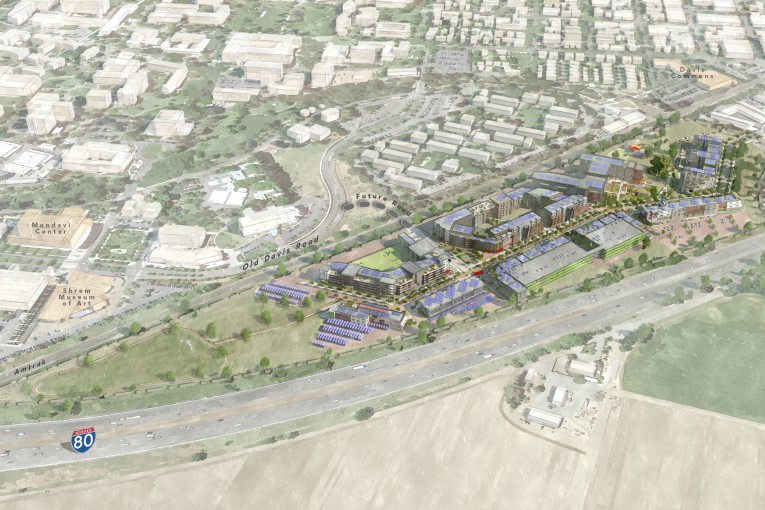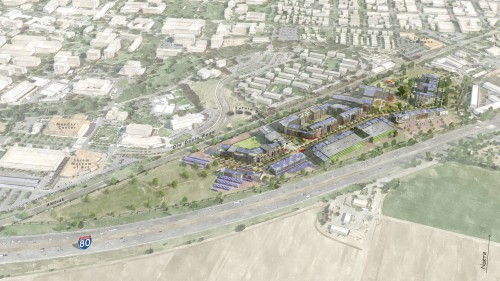

The city of Davis has released the Final Environmental Impact Report on Nishi (you can read it here). The city released the Draft EIR on September 10, which evaluated two major components of the project known as the Nishi Gateway project.
The Final EIR contains written comments from the community and the response to each of those comments. None of the comments have triggered the need for recirculation of the Draft EIR.
The project applicants on Wednesday afternoon put out a release ahead of the planning commission workshop. The planning commission will weigh in on the project on January 6.
The release stated that “the City of Davis’s Planning Commission will host a meeting focused on the innovative Nishi Gateway project, a live-work space on underutilized land adjacent to downtown and the UC Davis campus. In their report to the Commission, city staff recommended the Commission vote to support the Nishi Gateway and noted that the project fulfills all eight of the Guiding Principles the City Council established to judge potential innovation centers.”
“Staff recommends approval of the applications. Staff believes that the project appropriately integrates the City goals for economic development, housing, environmental sustainability, community character, and fiscal responsibility,” the staff report states.
“Nishi Gateway represents a culmination of concerted community engagement, incorporation of community input, and ground-up integration of sound land use, urban design, and sustainability principles,” they added. “The proposal successfully achieves a very difficult balance of multiple and diverse policy objectives.”
“I’ve appreciated city staff’s commitment to making sure the opportunities presented by the Nishi Gateway are fully realized and understood by our city’s decision makers,” said Tim Ruff, managing partner of the Nishi Gateway. “Throughout this process, we’ve listened to and incorporated feedback from the city, county, university, and community neighbors. Together, we’ve made the Nishi Gateway an even better project, and I’m confident Davis residents will give it their vote of approval if given the chance.”
The eight Guiding Principles identified by city staff and city council include:
- Density. The staff report highlights “the limited supply of land available in Davis, and the need to maximize density,” and recognizes that Nishi meets these goals.
- Sustainability. The staff report identifies at least nine different ways the project provides “significant sustainability commitments,” including the approach towards net-zero energy goals and the installation of onsite photovoltaic solar panels that will generate approximately 85 percent of the energy needed for the site. “The project has the potential for sustainability components stronger than any development in Davis,” staff wrote.
- Transportation. The staff report notes that the project makes major advances for public transportation and cycling and pedestrian features, including “the new multimodal connections from Olive Drive and Old Davis Road.” Staff notes that the Nishi Gateway developers are continuing to work with the city and university to ensure that the project will have two access points for vehicular traffic as a condition of approval.
- Work Environment. The staff report emphasizes Nishi Gateway’s commitment to flexible work spaces to help accommodate a wide range of businesses. “Internal open space and bicycle/pedestrian connectivity forms the backbone of the subdivision layout,” staff wrote.
- Uses. The staff report notes that “the range of unit sizes, reductions in resident energy costs, and support for ‘car-free’ living may all reduce household expenses and increase overall affordability for residents.” Staff also identifies “nascent firms in need of incubation and acceleration” as “natural candidates” for Nishi. “Nishi will be an early bellwether for interest among industries seeking expanded access and affiliation with UC Davis researchers,” staff wrote.
- Timing and Project Phasing. The staff report provides an update on ongoing discussions between the city and developers on additional revenue for city infrastructure. “The Development Agreement is anticipated to acknowledge the need for a Community Facilities District to provide the resources for backbone infrastructure,” staff wrote.
- Fiscal Consideration and Net Community Benefit. The project report identifies several ways the Nishi Gateway can provide an annual net fiscal surplus for the city, including an onsite hotel. The staff report also notes that “the property owner has committed to a mechanism for offsetting any foregone property tax revenue to the City as a result of purchase or lease of the non-residential properties by the University of California.” Moreover, “The Nishi project is estimated to produce an ongoing economic impact in the Davis economy that totals between 1,500 and 1,800 jobs, $315 million and $385 million of output, and $89 million and $107 million of labor income,” staff wrote.
- Facilitate Collaborative Partnerships and Provide Opportunities for Increased University and Research Engagement. The staff report notes that “a Mixed-Use Innovation District on the Nishi site, West Olive Drive, and adjacent UC Davis lands has been a common goal of the City, UC Davis, and Yolo County for several years.” Furthermore, “the site’s location, proximate to downtown Davis and the UC Davis campus, lends itself to strengthening physical connections and economic partnerships between the City and the University,” they wrote.
A few weeks ago, the Davis City Council expressed concerns about the lack of university access in the form of a grade-separated crossing.
Mayor Pro Tem Robb Davis stated, “I will not vote to put this on the ballot in June without conditions related to access. The cleanest way is to say no undercrossing at the railroad – no project. No improvements to Richards – no project.”
However, like his colleagues, he said, “I’m willing to see what we can come up with in terms of this other way that may allow certain things to go forward in a phased way, but no further. With the idea that the actual, that’s on the table in front of us cannot be developed without the second crossing.”
Councilmember Brett Lee said, “I’m a little bit uncomfortable with this notion that we’re supportive of the June ballot and asking staff to come back and address some concerns.” He said that staff could come back with the proposal that he is either supportive or not supportive of, depending on the specifics.
He said that, while he was in generally in favor of a June ballot for this project, he wants to see specific things before he will support that project. “The actual specifics make a lot of difference,” he said. “Even with the second crossing,” he said, “there are many shapes and sizes of this project that would not be acceptable to me.”
Councilmember Lucas Frerichs added that the issues of access have been the key topic since this project was first discussed. “Access to this site,” he said, “that is the linchpin across which the success or failure of the site hinges upon. For me, particularly the proposed grade-separated crossing the tunnel through the university, having that second access point, is absolutely essential.”
Councilmember Rochelle Swanson also agreed, saying that “that access point with the university, that’s essential for the success of the project and it’s also essential for the success of the applicant going through and moving it forward.”
—David M. Greenwald reporting

So what’s the numbers? How much revenue is Nishi going to generate for the city?
BP, an EIR does not contain that kind of financial analysis. The study completed by EPS is where the fiscal analysis happens. That document is not changed by the release of the final EIR.
Literally, the first thing that popped in my mind when I opened the link and saw the cover sheet of the FEIR …
http://aht.seriouseats.com/images/20101112-adrealityfastfood.jpg
LOL, that’s what I’m afraid of too.
Same at MRIC, we were promised an Angus Deluxe Burger but they’re trying hard to give us the Hot Dog.
the key question isn’t the eir at this point, it’s what will the council accept.